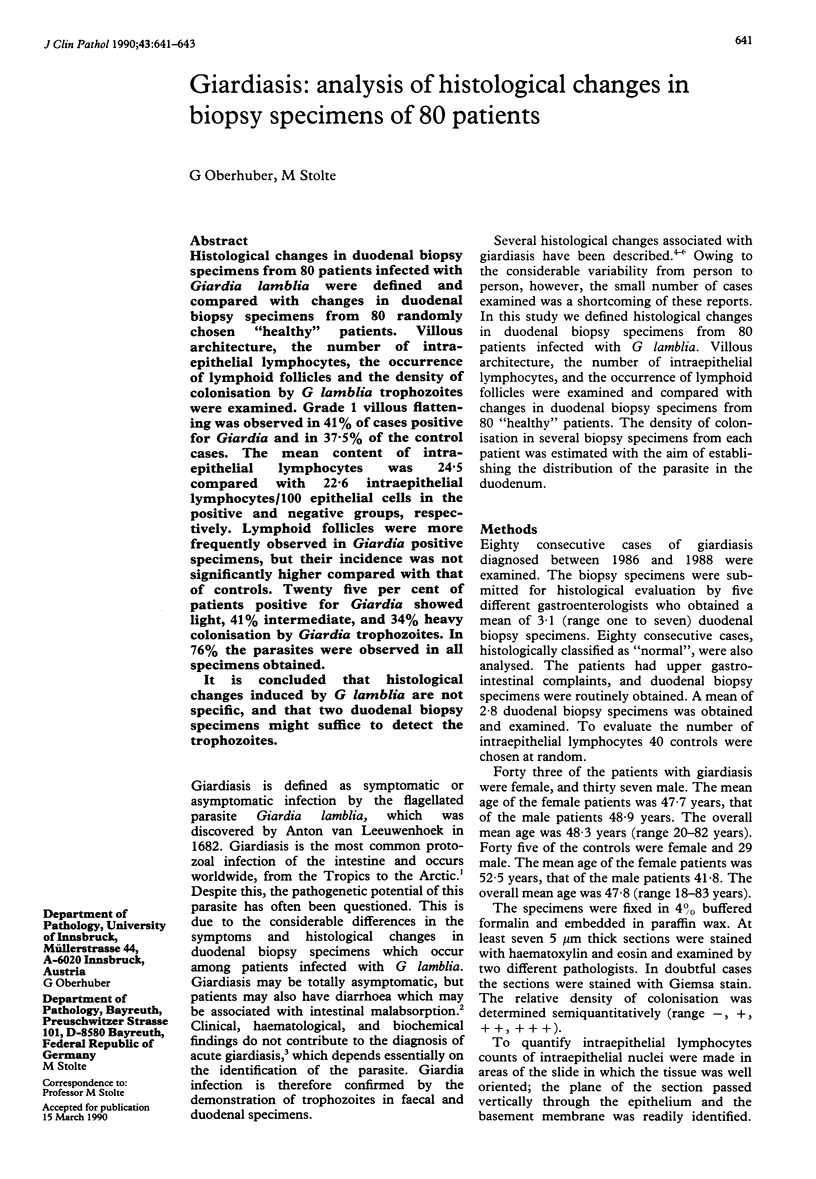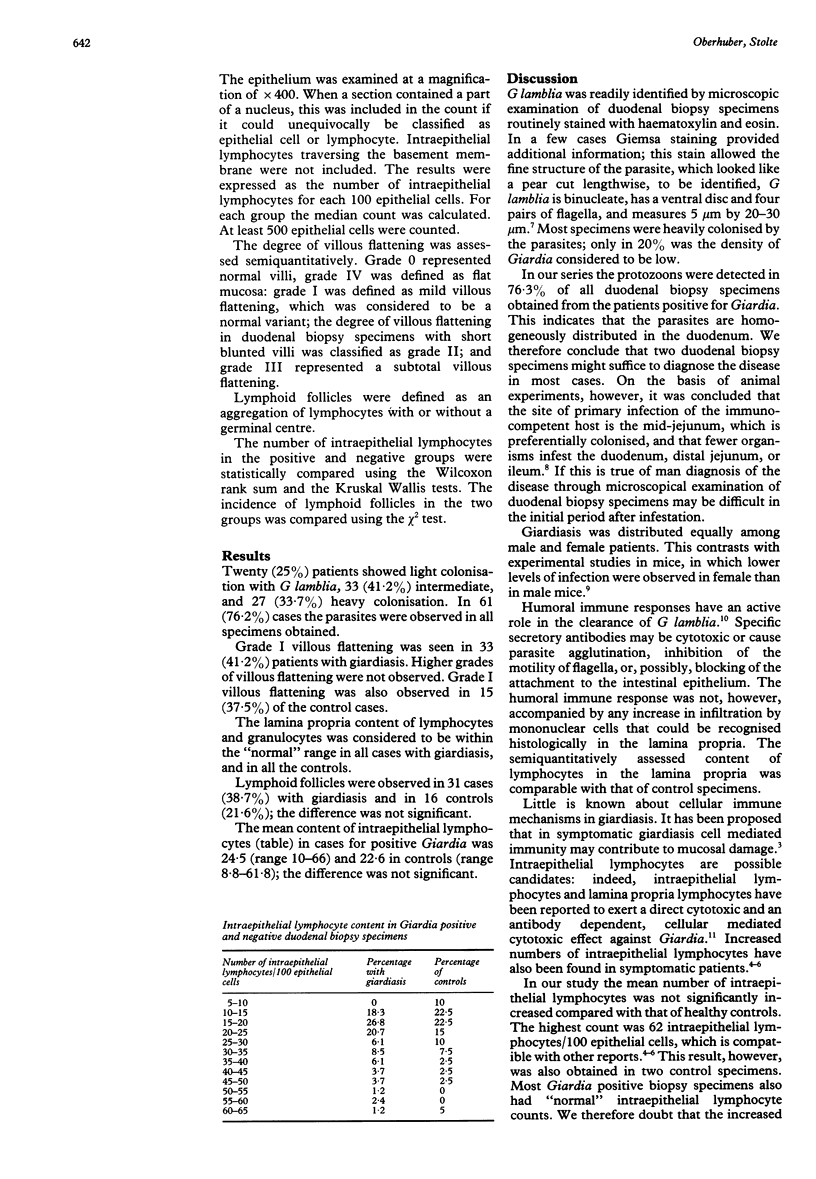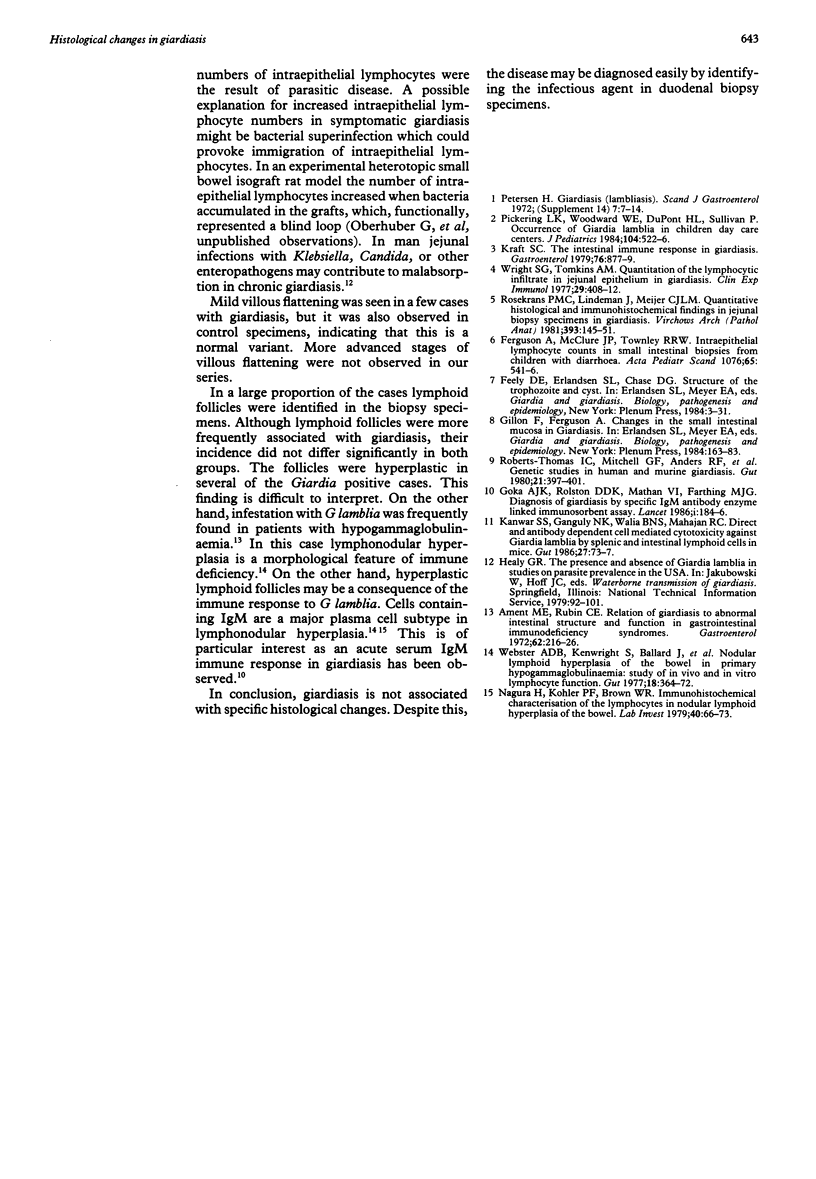Abstract
Histological changes in duodenal biopsy specimens from 80 patients infected with Giardia lamblia were defined and compared with changes in duodenal biopsy specimens from 80 randomly chosen "healthy" patients. Villous architecture, the number of intraepithelial lymphocytes, the occurrence of lymphoid follicles and the density of colonisation by G lamblia trophozoites were examined. Grade 1 villous flattening was observed in 41% of cases positive for Giardia and in 37.5% of the control cases. The mean content of intraepithelial lymphocytes was 24.5 compared with 22.6 intraepithelial lymphocytes/100 epithelial cells in the positive and negative groups, respectively. Lymphoid follicles were more frequently observed in Giardia positive specimens, but their incidence was not significantly higher compared with that of controls. Twenty five per cent of patients positive for Giardia showed light, 41% intermediate, and 34% heavy colonisation by Giardia trophozoites. In 76% the parasites were observed in all specimens obtained. It is concluded that histological changes induced by G lamblia are not specific, and that two duodenal biopsy specimens might suffice to detect the trophozoites.
Full text
PDF


Selected References
These references are in PubMed. This may not be the complete list of references from this article.
- Ament M. E., Rubin C. E. Relation of giardiasis to abnormal intestinal structure and function in gastrointestinal immunodeficiency syndromes. Gastroenterology. 1972 Feb;62(2):216–226. [PubMed] [Google Scholar]
- Goka A. K., Rolston D. D., Mathan V. I., Farthing M. J. Diagnosis of giardiasis by specific IgM antibody enzyme-linked immunosorbent assay. Lancet. 1986 Jul 26;2(8500):184–186. doi: 10.1016/s0140-6736(86)92487-6. [DOI] [PubMed] [Google Scholar]
- Kanwar S. S., Ganguly N. K., Walia B. N., Mahajan R. C. Direct and antibody dependent cell mediated cytotoxicity against Giardia lamblia by splenic and intestinal lymphoid cells in mice. Gut. 1986 Jan;27(1):73–77. doi: 10.1136/gut.27.1.73. [DOI] [PMC free article] [PubMed] [Google Scholar]
- Kraft S. C. The intestinal immune response in giardiasis. Gastroenterology. 1979 Apr;76(4):877–879. [PubMed] [Google Scholar]
- Nagura H., Kohler P. F., Brown W. R. Immunocytochemical characterization of the lymphocytes in nodular lymphoid hyperplasia of the bowel. Lab Invest. 1979 Jan;40(1):66–73. [PubMed] [Google Scholar]
- Pickering L. K., Woodward W. E., DuPont H. L., Sullivan P. Occurrence of Giardia lamblia in children in day care centers. J Pediatr. 1984 Apr;104(4):522–526. doi: 10.1016/s0022-3476(84)80540-5. [DOI] [PubMed] [Google Scholar]
- Roberts-Thomson I. C., Mitchell G. F., Anders R. F., Tait B. D., Kerlin P., Kerr-Grant A., Cavanagh P. Genetic studies in human and murine giardiasis. Gut. 1980 May;21(5):397–401. doi: 10.1136/gut.21.5.397. [DOI] [PMC free article] [PubMed] [Google Scholar]
- Rosekrans P. C., Lindeman J., Meijer C. J. Quantitative histological and immunohistochemical findings in jejunal biopsy specimens in giardiasis. Virchows Arch A Pathol Anat Histol. 1981;393(2):145–151. doi: 10.1007/BF00431071. [DOI] [PubMed] [Google Scholar]
- Webster A. D., Kenwright S., Ballard J., Shiner M., Slavin G., Levi A. J., Loewi G., Asherson G. L. Nodular lymphoid hyperplasia of the bowel in primary hypogammaglobulinaemia: study of in vivo and in vitro lymphocyte function. Gut. 1977 May;18(5):364–372. doi: 10.1136/gut.18.5.364. [DOI] [PMC free article] [PubMed] [Google Scholar]
- Wright S. G., Tomkins A. M. Quantification of the lymphocytic infiltrate in jejunal epithelium in giardiasis. Clin Exp Immunol. 1977 Sep;29(3):408–412. [PMC free article] [PubMed] [Google Scholar]


